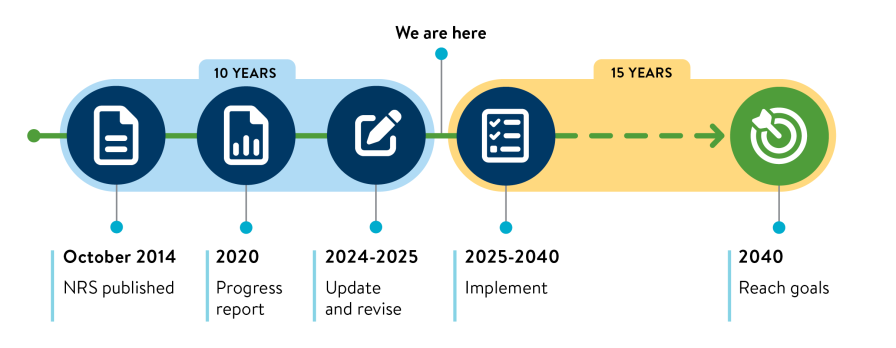The Minnesota Nutrient Reduction Strategy (NRS) compiles the latest science, research, and data and recommends the most effective strategies to reduce nutrients in our waters from both point and nonpoint sources. The strategy serves as a framework, outlining how voluntary and regulatory actions can reduce nutrient pollution to meet long-term goals. When nutrient levels exceed natural conditions, they can cause excessive algae growth, low levels of oxygen, toxicity to aquatic life, and unhealthy drinking water. Reductions in Minnesota’s nitrogen and phosphorus pollution are needed to reach our in-state water quality goals and the goals that aim to restore the Gulf, Lake Winnipeg, and Lake Superior.
2025 draft
The draft Minnesota NRS was released in June 2025 and is expected to be published as a final strategy in early 2026. The updated strategy presents many decades of progress that has helped reduce phosphorus in our water, shows mixed results on nitrogen, and identifies where work should be intensified.
Extensive public outreach has been conducted throughout the update process. As teams worked on the 2025 Minnesota NRS, they hosted numerous webinars, panel discussions, and presentations.
- June 2024 - Kickoff for Minnesota NRS update
- August 2024 - River nutrient levels: What’s in the water?
- March 2025 – Interactive water quality maps: Tracking progress
- July 15, 2025 - Overview of draft 2025 update (75 min.)
- July 24, 2025 - Q&A on the draft 2025 update (90 min.)

Tracking progress
Adoption of best management practices (BMP) to reduce excess nutrients is tracked through state and federal government programs; the links below lead to interactive reports. Additional best management practice adoption occurs outside of government programs.
- Best management practice adoption summary — statewide, large scale (2004-2023)
- Best management practice adoption summary — local level, watershed scale (2004-2023)
- BMP effects estimator tool (BEET) planner - Tool to estimate nutrient reduction in rivers and streams from future best management practice adoption scenarios
- BMP effects estimator tool (BEET) tracker - Tool to estimate nutrient reduction in rivers and streams from existing best management practices and progress towards meeting reduction goals set by the Minnesota Nutrient Reduction Strategy
Urban wastewater nutrient discharge: Annual pollutant load trends and effluent concentrations and flows from wastewater treatment plants are tracked by facility and major watershed for total nitrogen and phosphorus as well other constituents.
River nutrient monitoring: The amount of nutrients in water is measured many times throughout the year. Each year, the MPCA updates river nutrient trends and river monitoring results on the most recently calculated loads and concentrations.
- Nutrient trends over time at MPCA-monitored sites (2001-2022)
- Daily and annual nutrient measurements at MPCA-monitored sites (approx. 2009-2021)
Minnesota NRS publications
Five-year progress report
This 2020 report by Minnesota state agencies details implementation of the Minnesota NRS from 2014 to 2019 and progress in three key areas: water quality trends, statewide programs to improve waters, and urban and rural practices adopted to reduce nutrients.
2014 Minnesota NRS
- (2014)
Watershed-based nutrient reduction efforts
Goals for nitrogen and phosphorus levels in waters downstream of Minnesota can be met if each watershed in our state does its part to reduce nutrients. The MPCA estimated how much nutrient reduction each watershed would be needed to achieve nutrient load reduction goals at the state line. This information can help us identify changes to achieve nutrient load reductions.
- This interim document will be updated in the 2025 NRS revision process.
- The Watershed pollutant load reduction calculator tool was developed to estimate typical river nutrient pollution reductions expected with adoption of new practices on the land.